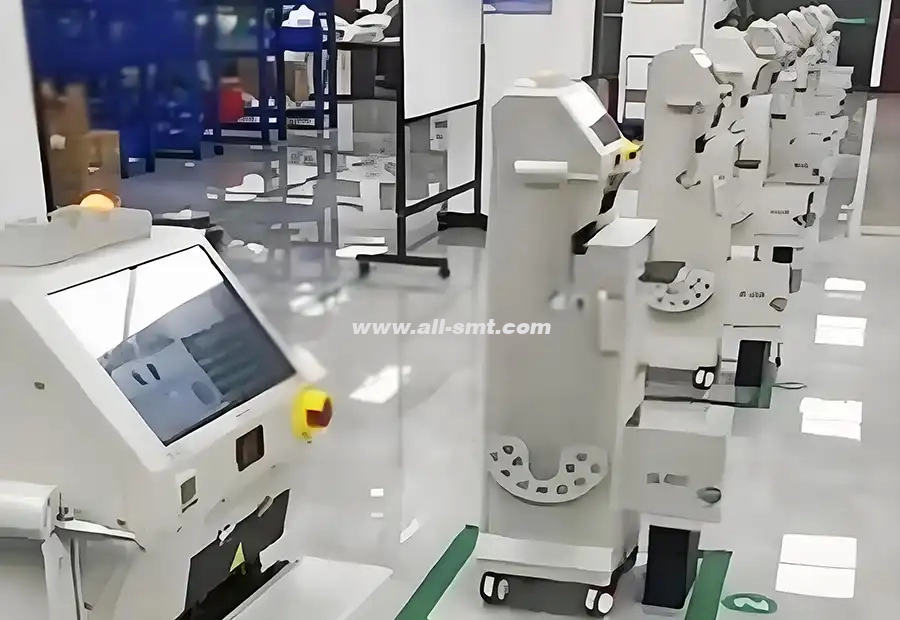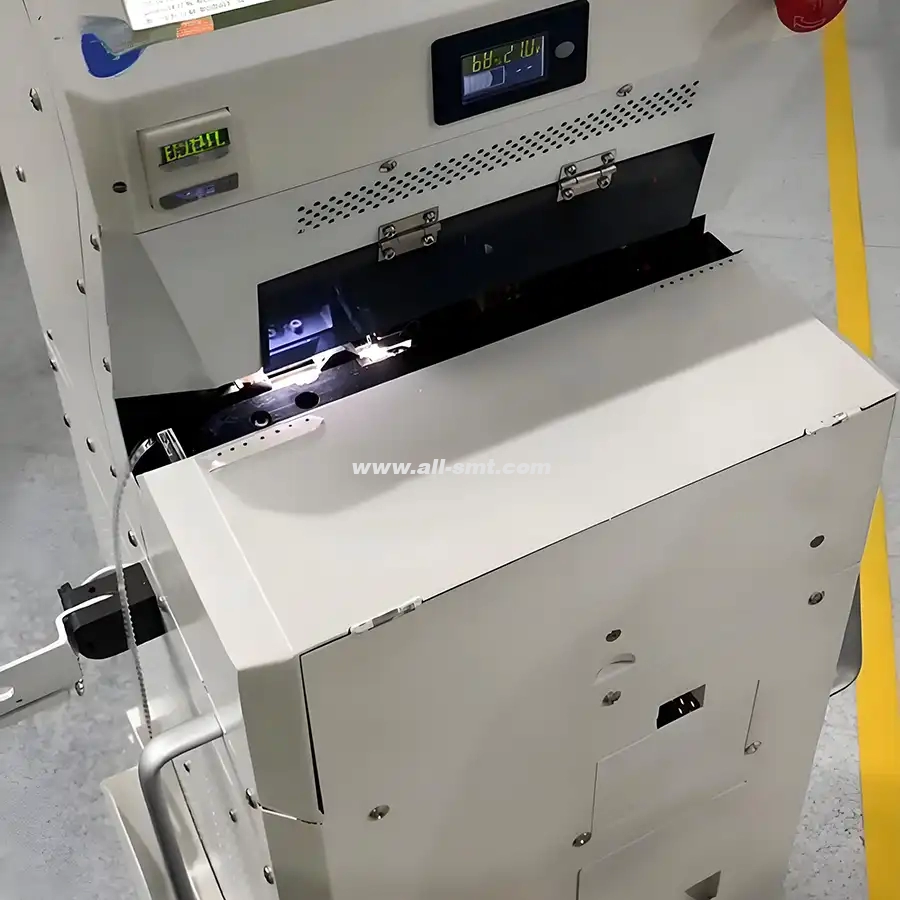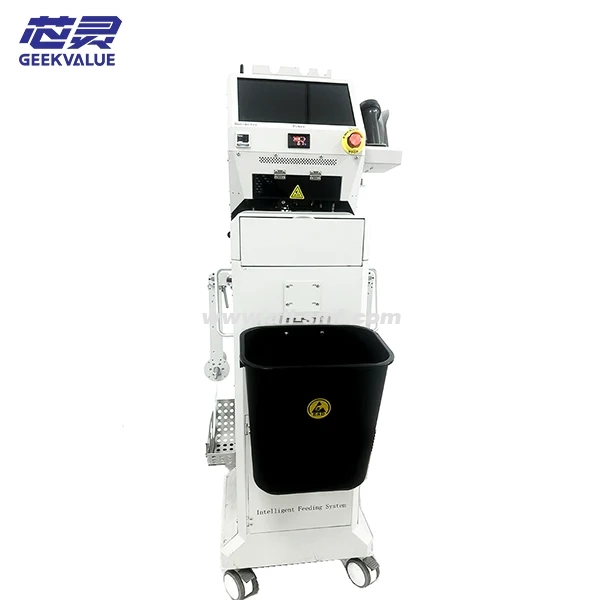Ekyuma kya auto splicer kye ki?
Ekyuma kya SMT auto splicer —era ekimanyiddwa nga automatic splicer oba automatic splicing machine —kikoleddwa okugatta otomatika SMT component reel empya ku eriwo awatali kuyimiriza kyuma kya pick-and-place. Ekyuma kino eky’okugatta mmotoka kikakasa okufulumya obutasalako, kikendeeza ku budde bw’okuyimirira, n’okulongoosa obulungi bw’okukola okutwalira awamu, ekikifuula kyetaagisa nnyo mu layini z’okukuŋŋaanya SMT ez’obuzito obw’amaanyi, okukola LED, n’okukola ebintu eby’amasannyalaze.

Ebikulu Ebirimu & Emigaso gy'Ekyuma kya SMT Automatic Splicer Machine
Okuyunga reel mu ngeri ey’otomaawatali kuyimiriza kukola SMT.
Ebiwagira8mm, 12mm, 16mm, ne 24mmobutambi obusitula ebintu.
Okulaganya okw’obutuufu obw’amaanyi okutangira ensobi mu kuliisa.
Kikendeeza ku nsaasaanya y’abakozi n’okumalawo ebyuma okuyimirira mu ngeri eteetaagisa.
Enkolagana ennyangu okukozesa okusobola okukola amangu n’okutendekebwa.
Ekwatagana n’ebika bya SMT ebikulu (Panasonic, Yamaha, FUJI, JUKI, Samsung).
Dizayini ewangaala okusobola okuwangaala n’okukola obulungi.
Ebikwata ku by’ekikugu
| Ekifaananyi | Obugazi bwa Tape | Amasannyalaze | Obudde bw’okugatta | Ebipimo (L×W×H) . | Kigambo |
|---|---|---|---|---|---|
| AS-800 | 8–24mm | AC 220V / 50Hz | ≤ sekondi 5 | 600×400×300mm | Kkiro 15 |
| AS-1200 | 8–32mm | AC 220V / 50Hz | ≤ sekondi 4 | 650×420×310mm | Kkiro 17 |
Engeri Ekyuma kya Auto Splicing gyekikola
Tikka ekitundu ekipya reel mu SMT splicer.
Ekyuma ekigatta otomatiki kizuula nga reel eriwo kati kumpi ewedde.
Enkola y’okuyunga (splicing mechanism) yeegatta ku ttaapu enkadde n’empya mu ngeri ey’otoma.
Okukola SMT kugenda mu maaso awatali kutaataaganyizibwa.

Enkozesa ya SMT Splicer
Layini z’okukuŋŋaanya PCB
Okukola LED
Ebyuma ebikozesebwa mu mmotoka
Okukola ebyuma by’empuliziganya
Ebyuma ebikozesebwa mu byuma bikalimagezi
Lwaki Londa Ekyuma Kyaffe Eky'okuyunga mu Butonde
| Ekintu eky'enjawulo | Okuyunga mu ngalo | Ekyuma Ekigatta Auto Splicing |
|---|---|---|
| Obudde bw’okuyimirira buli reel | eddakiika 5–10 | 0 eddakiika |
| Obutuufu bw’okuyunga | Midiyamu | Waggulu |
| Okwetaaga kw’abakozi | Waggulu | Wansi |
| Okufiirwa kw’ebintu ebikolebwa | Waggulu | Ekitono ennyo |
Empeereza y’oluvannyuma lw’okutunda
Waranti ya mwaka gumu ng’olina obuyambi obw’ekikugu obw’obwereere
Okutendekebwa mu kifo n’okuyambibwako okuteeka
24/7 okuddamu mu mpeereza ya bakasitoma
Okusindika mu nsi yonna kuliwo

Ebibuuzo ebibuuzibwa
-
Otomatiki splicer ekozesebwa ki mu kukola SMT?
Ekyuma ekigatta otomatiki kikozesebwa okugatta obutambi bw’ebitundu bya SMT awatali kuyimiriza kyuma kya pick-and-place, okukakasa nti okufulumya obutasalako.
-
SMT splicer esobola okukola ne feeder brands ez’enjawulo?
Yee, ekwatagana n’ebika by’emmere ebisinga obungi omuli Panasonic, Yamaha, FUJI, JUKI, ne Samsung.
-
Obugazi bwa tape ki ekyuma kya auto splicer kye kiyinza okukwata?
Ewagira obutambi obusitula mmita 8, mm 12, mm 16, ne mm 24.
-
Okutendekebwa okw’enjawulo kwetaagibwa okusobola okukola ekyuma ekigatta ebyuma mu ngeri ey’otoma?
Nedda, okulongoosa kwangu, era okutendekebwa okusookerwako kutwala essaawa ezitakka wansi wa 1.






